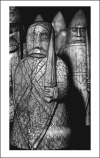 |
Scottish Annotated Games |
Last updated 11 July 2001


|
Borwell, A P - Doye,P [C00]
British CC Championships 1999
[Notes by Alan Borwell]
1.e4 [I decided to emply a rather unusual line against the French,
which is designed to take the Black player into an open and tactical
position, in which he might not be entirely comfortable. It also has the
considerable advantage of gambiting an early pawn, which, in the days of
computers, is quite a good way of avoiding positions where piece valuation
is an important factor. Of course, I have no idea whether my opponent
might have access to a computer program, but I rather like the idea of an
early departure into uncharted and unbalanced positions.]
1...e6 2.b3
[This move is much better than its reputation, for the reasons I have
already given above.]
2...d5 3.Bb2 dxe4 [Black is better to take the
pawn because 3. ...Nf6 4.exd5 exd5 5.Qe2+!? Be6 6.Nf3 Be7 7.Ng5 is promising
for White.]
4.Nc3 Nf6 5.Qe2 Bb4 [If 5. ... Be7 6.Nxe4 Nxe4 7.Qxe4 Bf6
8.d4 Qd5 9.Qe3 0-0 10.0-0-0 Nc6 11.Nf3 is good for White. Totsky-Rapport,
Minsk, 1996, saw White winning in 16 moves!]
6.0-0-0 Bxc3 [Here 6.
... Qe7 is playable but 7.Nxe4 or 7.Kb1 both give White excellent chances.]
7.dxc3! Qe7 8.g4 [White has two bishops, an advantage in development,
and a tactical initiative!]
8...Qc5 [This was unexpected, but 8. ...
h6 9.Bg2 e5 10.h3 Bd7 11.Qe3! Bc6 12.c4 Nbd7 13.Ne2 0-0 14.Ng3 is promising
for White. I think that 8. ... Qc5 is better and requires White to play
strongly for advantage.]
9.h4 h6 10.Bg2 Nc6 11.Bxe4 [I was a little
reluctant to exchange one of my bishops for a knight, but White must open up
lines quickly.]
11...h5 12.g5 Nxe4 13.Qxe4 Qxf2 [Here a computer
would probably give a favourable assessment to Black, but the position is
clearly better for White.]
14.Nh3 Qc5 [If 14. ... Qf5, then 15.Qxf5
exf5 16.Rhe1+ Be6 17.Nf4 Rd8 18.Rxd8+ Kxd8 19.c4 Rg8 20.Nxh5 g6 21.Nf6 Rh8
22.h5 gxh5 23.g6 fxg6 24.Rxe6 h4 25.Nd5 Rg8 26.Kd2 and White's extra piece
and greater activity will decide.]
15.c4 e5 16.Nf4 Bg4 17.Ng6!!
[Much better than 17.Rd2 0-0! 18.Nd5 Qe7 when, if White captures on e5,
the pin after Re8 is a real nuisance. If 17.Rd5 Qe7 18.Bxe5 0-0 19.Re1,
then Black has several plausible moves. White's position may look
menacing, but there is a lack of piece cohesion for attacking purposes.
The move played is much more dynamic and forcing.]
17...Bxd1 18.Rxd1
fxg6? [Better is 18. ... Rd8 19.Rxd8 Nxd8 20.Nxh8 Qg1+ 21.Kd2 Qf2+
22.Kd1 when Black may even escape with a draw. However, White could have a
better continuation! The finish now is rather elegant.]
19.Qxg6+ Kf8
20.Rf1+ Kg8 21.Qe6+ Kh7 22.g6+ Kh6 23.Kb1 Qe3 [The only move to stop
mate.]
24.Bc1 Qxc1+ 25.Kxc1 Rhf8 [It looks as though Black may have
escaped from immediate disaster and could still have some chances despite
the material, but...]
26.Rxf8 Rxf8 27.Qf7!! [If the Black rook moves
to another file, White mates the trapped king via f5/g5. Capture of the
queen simply allows White to convert the pawn into another one - so it's all
over!] 1-0
| Click to return to index page Games Index |
Click to download in PGN format Borwell v Doye |
Generated with ChessBase 7.0 |





















